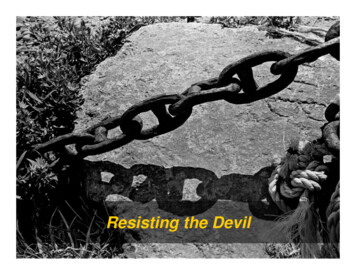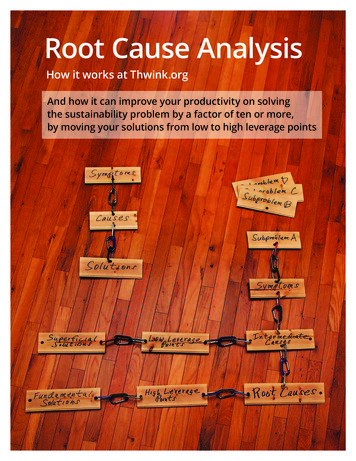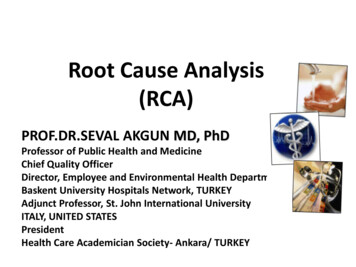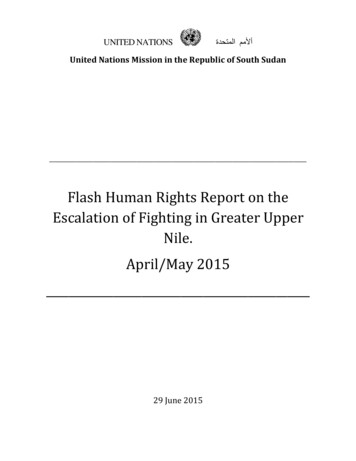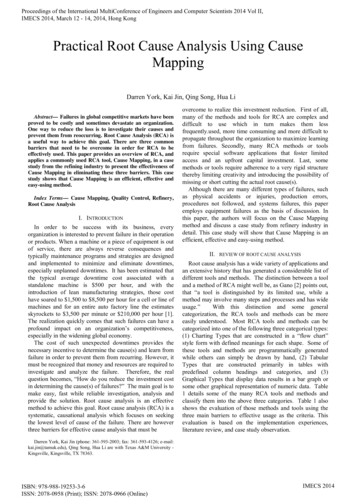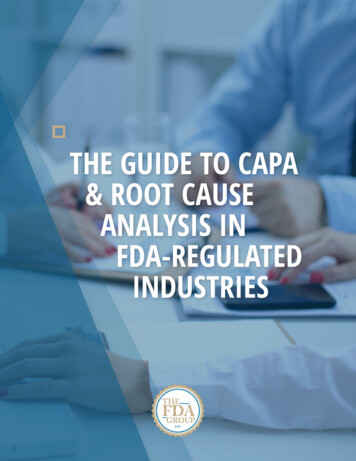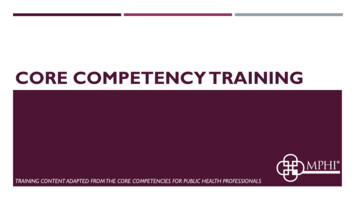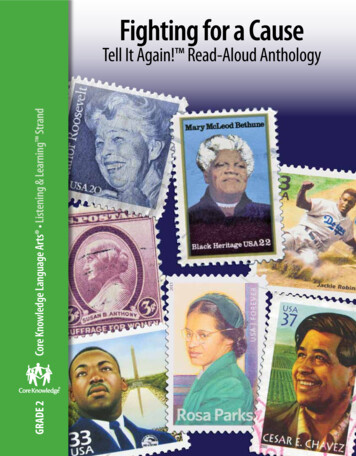
Transcription
Grade 2Core Knowledge Language Arts Listening & Learning StrandFighting for a CauseTell It Again! Read-Aloud Anthology
Fighting for a CauseTell It Again! Read-Aloud AnthologyListening & Learning StrandGrade 2Core Knowledge Language Arts
Creative Commons LicensingThis work is licensed under a Creative Commons AttributionNonCommercial-ShareAlike 3.0 Unported License.You are free:to Share — to copy, distribute and transmit the workto Remix — to adapt the workUnder the following conditions:Attribution — You must attribute the work in thefollowing manner:This work is based on an original work of the CoreKnowledge Foundation made available throughlicensing under a Creative Commons AttributionNonCommercial-ShareAlike 3.0 Unported License. Thisdoes not in any way imply that the Core KnowledgeFoundation endorses this work.Noncommercial — You may not use this work forcommercial purposes.Share Alike — If you alter, transform, or build upon thiswork, you may distribute the resulting work only underthe same or similar license to this one.With the understanding that:For any reuse or distribution, you must make clear toothers the license terms of this work. The best way todo this is with a link to this web 3.0/Copyright 2013 Core Knowledge Foundationwww.coreknowledge.orgAll Rights Reserved.Core Knowledge Language Arts, Listening & Learning,and Tell It Again! are trademarks of the Core KnowledgeFoundation.Trademarks and trade names are shown in this book strictlyfor illustrative and educational purposes and are the propertyof their respective owners. References herein should notbe regarded as affecting the validity of said trademarks andtrade names.
Table of ContentsFighting for a CauseTell It Again! Read-Aloud AnthologyAlignment Chart for Fighting for a Cause . . . . . . . . . . . . . . . . . . . . . . . . . . . . . . . . . . . . . . . . . . . . . . . . vIntroduction to Fighting for a Cause . . . . . . . . . . . . . . . . . . . . . . . . . . . . . . . . . . . . . . . . . . . . . . . . . . . 1Lesson 1: People Who Fought for a Cause . . . . . . . . . . . . . . . . . . . . . . . . . . . . . . . . . . . . . . . . . . . . . . . 14Lesson 2: Susan B. Anthony: An Advocate for Women’s Rights . . . . . . . . . . . . . . . . . . . . . . . . . . . . . . . . . . . 30Lesson 3: Eleanor Roosevelt: A Voice for Human Rights . . . . . . . . . . . . . . . . . . . . . . . . . . . . . . . . . . . . . . . 42Lesson 4: Mary McLeod Bethune: A Dedicated Teacher . . . . . . . . . . . . . . . . . . . . . . . . . . . . . . . . . . . . . . . 56Lesson 5: Jackie Robinson: Champion of Equality . . . . . . . . . . . . . . . . . . . . . . . . . . . . . . . . . . . . . . . . . . . 70Pausing Point . . . . . . . . . . . . . . . . . . . . . . . . . . . . . . . . . . . . . . . . . . . . . . . . . . . . . . . . . . . . . . . 85Lesson 6: Rosa Parks: The Mother of the Civil Rights Movement . . . . . . . . . . . . . . . . . . . . . . . . . . . . . . . . . . 91Lesson 7: Martin Luther King Jr.: Defender of the Dream . . . . . . . . . . . . . . . . . . . . . . . . . . . . . . . . . . . . . . 105Lesson 8: Cesar Chavez: Protector of Workers’ Rights . . . . . . . . . . . . . . . . . . . . . . . . . . . . . . . . . . . . . . . . 119Lesson 9: Celebrating Those Who Fought for a Cause . . . . . . . . . . . . . . . . . . . . . . . . . . . . . . . . . . . . . . . . 136Domain Review . . . . . . . . . . . . . . . . . . . . . . . . . . . . . . . . . . . . . . . . . . . . . . . . . . . . . . . . . . . . . . 148Domain Assessment . . . . . . . . . . . . . . . . . . . . . . . . . . . . . . . . . . . . . . . . . . . . . . . . . . . . . . . . . . 152Culminating Activities . . . . . . . . . . . . . . . . . . . . . . . . . . . . . . . . . . . . . . . . . . . . . . . . . . . . . . . . . 156Appendix . . . . . . . . . . . . . . . . . . . . . . . . . . . . . . . . . . . . . . . . . . . . . . . . . . . . . . . . . . . . . . . . . . 159
Alignment Chart for Fighting for a CauseThe following chart contains the core content objectives addressedin this domain. It also demonstrates alignment between the CommonCore State Standards and corresponding Core Knowledge LanguageArts (CKLA) goals.Alignment Chart for Fighting for a CauseLesson123456789Core Content ObjectivesExplain that members of one powerful group often excludedmembers of other groups from certain rightsPDescribe how organizations and movements, such as the civilrights movement, were created as people fought for equal rightsPExplain why fighting for important causes has helped to changelaws and improve the lives of many peoplePExplain the terms inequality, discrimination, suffrage, segregation,and activistP P PExplain the concepts of nonviolence, civil rights, and human rightsPP P P P PP P P P P P PDescribe the lives and contributions of Susan B. Anthony, EleanorRoosevelt, Mary McLeod Bethune, Jackie Robinson, Rosa Parks,Dr. Martin Luther King Jr., and Cesar ChavezP P P P P P PIdentify the main causes for which Susan B. Anthony, EleanorRoosevelt, Mary McLeod Bethune, Jackie Robinson, Rosa Parks,Dr. Martin Luther King Jr., and Cesar Chavez fought during theirlifetimesP P P P P P P PIdentify Susan B. Anthony as an abolitionistPExplain that Susan B. Anthony campaigned for women’s rights,especially the right to votePExplain that Eleanor Roosevelt was married to President FranklinRooseveltPIdentify Eleanor Roosevelt as a First LadyPIdentify the Great Depression as a difficult time in American historyPExplain the role of the United Nations in the worldPExplain that Mary McLeod Bethune worked with EleanorRooseveltPExplain the lack of educational opportunities for African Americangirls in the nineteenth centuryPFighting for a Cause Alignment Chart 2013 Core Knowledge Foundationv
Alignment Chart for Fighting for a CauseLesson1Explain that three presidents asked Mary McLeod Bethune foradvice23456789PExplain that Jackie Robinson was a talented athletePIdentify Jackie Robinson as the first African American to playMajor League Baseball in the United StatesPExplain the importance of the success of the Montgomery BusBoycottPPDescribe the connection between Rosa Parks and Martin LutherKing Jr.PIdentify Martin Luther King Jr. as an important leader of the civilrights movementP PPDescribe working conditions for migrant workersDescribe the similarities among the causes supported by SusanB. Anthony, Eleanor Roosevelt, Mary McLeod Bethune, JackieRobinson, Rosa Parks, Dr. Martin Luther King Jr., and CesarChavezPDescribe the similarities among the methods of protest used bySusan B. Anthony, Eleanor Roosevelt, Mary McLeod Bethune,Jackie Robinson, Rosa Parks, Dr. Martin Luther King Jr., andCesar ChavezPReading Standards for Literature: Grade 2Craft and StructureSTD RL.2.4Describe how words and phrases (e.g., regular beats, alliteration, rhymes, repeated lines) supply rhythm andmeaning in a story, poem, or song.CKLAGoal(s)Describe how words and phrases (e.g., regularbeats, alliteration, rhymes, repeated lines) supplyrhythm and meaning in a story, poem, or songviFighting for a Cause Alignment Chart 2013 Core Knowledge FoundationP P P P P P P P
Alignment Chart for Fighting for a CauseLesson123456789Reading Standards for Informational Text: Grade 2Key Ideas and DetailsSTD RI.2.1CKLAGoal(s)Ask and answer such questions as who, what, where, when, why, and how to demonstrate understanding ofkey details in a text.Ask and answer questions (e.g., who, what,where, when, why, and how), orally or in writing,requiring literal recall and understanding of thedetails and/or facts of a nonfiction/informationalread-aloudPAnswer questions that require makinginterpretations, judgments, or giving opinionsabout what is heard in a nonfiction/informationalread-aloud, including answering whyquestions that require recognizing cause/effectrelationshipsPSTD RI.2.2Identify the main topic of a multiparagraph text as well as the focus of specific paragraphs within the text.CKLAGoal(s)Identify the main topic of a multiparagraphnonfiction/informational read-aloud as well as thefocus of specific paragraphs within the textSTD RI.2.3Describe the connection between a series of historical events, scientific ideas or concepts, or steps in technicalprocedures in a text.CKLAGoal(s)Describe the connection between a series ofhistorical events, scientific ideas or concepts,or steps in technical procedures in a nonfiction/informational read-aloudPPPP PCraft and StructureSTD RI.2.4Determine the meaning of words and phrases in a text relevant to a Grade 2 topic or subject area.CKLAGoal(s)Determine the meaning of unknown words andphrases in nonfiction/informational read-aloudsand discussionsSTD RI.2.6Identify the main purpose of a text, including what the author wants to answer, explain, or describe.CKLAGoal(s)Identify the main purpose of a nonfiction/informational read-aloud, including what theauthor wants to answer, explain, or describePPFighting for a Cause Alignment Chart 2013 Core Knowledge Foundationvii
Alignment Chart for Fighting for a CauseLesson123456789Integration of Knowledge and IdeasSTD RI.2.7Explain how specific images (e.g., a diagram showing how a machine works) contribute to and clarify a text.CKLAGoal(s)Interpret information from diagrams, charts,timelines, graphs, or other organizers associatedwith a nonfiction/informational read-aloud, andexplain how these graphics clarify the meaning ofthe read-aloudSTD RI.2.8Describe how reasons support specific points the author makes in a text.CKLAGoal(s)Describe how reasons or facts support specificpoints the author makes in a nonfiction/informational read-aloudSTD RI.2.9Compare and contrast the most important points presented by two texts on the same topic.CKLAGoal(s)Compare and contrast (orally or in writing)similarities and differences within a singlenonfiction/informational read-aloud or betweentwo or more nonfiction/informational read-aloudsP P P P P P PPPRange of Reading and Level of Text ComplexitySTD RI.2.10By the end of year, read and comprehend informational texts, including history/social studies, science, andtechnical texts, in the Grades 2–3 text complexity band proficiently, with scaffolding as needed at the high endof the range.CKLAGoal(s)Listen to and demonstrate understandingof nonfiction/informational read-alouds ofappropriate complexity for Grades 2–4PWriting Standards: Grade 2Text Types and PurposesSTD W.2.1Write opinion pieces in which they introduce the topic or book they are writing about, state an opinion, supplyreasons that support the opinion, use linking words (e.g., because, and, also) to connect opinion and reasons,and provide a concluding statement or section.CKLAGoal(s)Plan, draft, and edit opinion pieces in whichthey introduce the topic or book they are writingabout, state an opinion, supply reasons thatsupport the opinion, use linking words (e.g.,because, and, also) to connect opinion andreasons, and provide a concluding statement orsectionviiiFighting for a Cause Alignment Chart 2013 Core Knowledge FoundationP P P P P P P
Alignment Chart for Fighting for a CauseLesson123456789Production and Distribution of WritingSTD W.2.5With guidance and support from adults and peers, focus on a topic and strengthen writing as needed byrevising and editing.CKLAGoal(s)With guidance and support from adults andpeers, focus on a topic and strengthen writing asneeded by revising and editingSTD W.2.6With guidance and support from adults, use a variety of digital tools to produce and publish writing, including incollaboration with peers.CKLAGoal(s)With guidance and support from adults, use avariety of digital tools to produce and publishwriting, including in collaboration with peersPPResearch to Build and Present KnowledgeSTD W.2.8CKLAGoal(s)Recall information from experiences or gather information from provided sources to answer a question.Make personal connections (orally or inwriting) to events or experiences in a fiction ornonfiction/informational read-aloud and/or makeconnections among several read-aloudsWith assistance, categorize and organize factsand information within a given domain to answerquestionsPP P P P P P PSpeaking and Listening Standards: Grade 2Comprehension and CollaborationSTD SL.2.1Participate in collaborative conversations with diverse partners about Grade 2 topics and texts with peers andadults in small and large groups.STD SL.2.1aFollow agreed-upon rules for discussions (e.g., gaining the floor in respectful ways, listening to others withcare, speaking one at a time about the topics and texts under discussion).CKLAGoal(s)Use agreed-upon rules for group discussions(e.g., look at and listen to the speaker, raisehand to speak, take turns, say “excuse me” or“please,” etc.)STD SL.2.1bBuild on others’ talk in conversations by linking their comments to the remarks of others.CKLAGoal(s)Carry on and participate in a conversation overat least six turns, staying on topic, linking theircomments to the remarks of others, with eitheran adult or another child of the same ageSTD SL.2.1cAsk for clarification and further explanation as needed about the topics and texts under discussion.CKLAGoal(s)Ask questions to clarify information about thetopic in a fiction or nonfiction/informational readaloudPPPFighting for a Cause Alignment Chart 2013 Core Knowledge Foundationix
Alignment Chart for Fighting for a CauseLesson123456789STD SL.2.2Recount or describe key ideas or details from a text read aloud or information presented orally or through othermedia.CKLAGoal(s)Retell (orally or in writing) important factsand information from a fiction or nonfiction/informational read-aloudSTD SL.2.3Ask and answer questions about what a speaker says in order to clarify comprehension, gather additionalinformation, or deepen understanding of a topic or issue.CKLAGoal(s)Ask questions to clarify directions, exercises,classroom routines and/or what a speaker saysabout a topic to gather additional information, ordeepen understanding of a topic or issueP PPP PPresentation of Knowledge and IdeasSTD SL.2.4Tell a story or recount an experience with appropriate facts and relevant, descriptive details, speaking audibly incoherent sentences.CKLAGoal(s)Recount a personal experience with appropriatefacts and relevant, descriptive details, speakingaudibly in coherent sentencesSTD SL.2.5Create audio recordings of stories or poems; add drawings or other visual displays to stories or recounts ofexperiences when appropriate to clarify ideas, thoughts, and feelings.CKLAGoal(s)Create audio recordings of stories or poems;add drawings or other visual displays to storiesor recounts of experiences when appropriate toclarify ideas, thoughts, and feelingsSTD SL.2.6Produce complete sentences when appropriate to task and situation in order to provide requested detail orclarification. (See Grade 2 Language.)CKLAGoal(s)Produce complete sentences when appropriateto task and situation in order to providerequested detail or clarificationPPP P PPLanguage Standards: Grade 2Vocabulary Acquisition and UseSTD L.2.5Demonstrate understanding of word relationships and nuances in word meanings.STD L.2.5aIdentify real-life connections between words and their use (e.g., describe foods that are spicy or juicy).CKLAGoal(s)xIdentify real-life connections between words andtheir use (e.g., describe foods that are spicy orjuicy)Determine the meaning of unknown andmultiple meaning words and phrases in fictionor nonfiction/informational read-alouds anddiscussionsFighting for a Cause Alignment Chart 2013 Core Knowledge FoundationPPP
Alignment Chart for Fighting for a CauseLesson123456789STD L.2.5bDistinguish shades of meaning among closely related verbs (e.g., toss, throw, hurl) and closely relatedadjectives (e.g., thin, slender, skinny, scrawny).CKLAGoal(s)Distinguish shades of meaning among closelyrelated verbs (e.g., toss, throw, hurl) and closelyrelated adjectives (e.g., thin, slender, skinny,scrawny)STD L.2.6Use words and phrases acquired through conversations, reading and being read to, and responding to texts,including using adjectives and adverbs to describe (e.g., When other kids are happy, that makes me happy).Learn the meaning of common sayings andphrasesCKLAGoal(s)PPPUse words and phrases acquired throughconversations, reading and being read to, andresponding to texts, including using adjectivesand adverbs to describe (e.g., When other kidsare happy, that makes me happy)PAdditional CKLA GoalsPrior to listening to a read-aloud, identify (orally or in writing) whatthey know and have learned that may be related to the specificstory or topic to be read aloudP P P P P P P PIdentify and express physical sensations, mental states, andemotions of self and othersP P P P P PShare writing with othersPUse knowledge of the meaning of individual words to predict themeaning of compound wordsPPThese goals are addressed in all lessons in this domain. Rather than repeat these goals as lessonobjectives throughout the domain, they are designated here as frequently occurring goals.99Fighting for a Cause Alignment Chart 2013 Core Knowledge Foundationxi
Introduction toFighting for a CauseThis introduction includes the necessary background informationto be used in teaching the Fighting for a Cause domain. The TellIt Again! Read-Aloud Anthology for Fighting for a Cause containsnine daily lessons, each of which is composed of two distinctparts, so that the lesson may be divided into smaller chunks oftime and presented at different intervals during the day. Eachentire lesson will require a total of sixty minutes.This domain includes a Pausing Point following Lesson 5. At theend of the domain, a Domain Review, a Domain Assessment,and Culminating Activities are included to allow time to review,reinforce, assess, and remediate content knowledge. You shouldspend no more than thirteen days total on this domain.Week OneDay 1Day 3Day 4Day 5Lesson 1A: “People WhoFought for a Cause”(40 min.)#Day 2Lesson 2A: “Susan B.Anthony: An Advocatefor Women’s Rights”(40 min.)#Lesson 3A: “EleanorRoosevelt: A Voice forHuman Rights” (40 min.)Lesson 4A: “MaryMcLeod Bethune: ADedicated Teacher”(40 min.)Lesson 5A: “JackieRobinson: Champion ofEquality” (40 min.)Lesson 1B: Extensions(20 min.)Lesson 2B: Extensions(20 min.)Lesson 3B: Extensions(20 min.)Lesson 4B: Extensions(20 min.)Lesson 5B: Extensions(20 min.)60 min.60 min.60 min.60 min.60 min.Week TwoDay 8Day 9Day 10Pausing Point (40 min.)Lesson 6A: “Rosa Parks:The Mother of the CivilRights Movement”(40 min.)Lesson 7A: “MartinLuther King Jr.: Defenderof the Dream” (40 min.)Lesson 8A: “CesarChavez: Protector ofWorkers’ Rights” (40 min.)Lesson 9A: “CelebratingThose Who Fought for aCause” (40 min.)Pausing Point (20 min.)Lesson 6B: Extensions(20 min.)Lesson 7B: Extensions(20 min.)Lesson 8B: Extensions(20 min.)Lesson 9B: Extensions(20 min.)60 min.60 min.60 min.60 min.60 min.Day 11Day 12 Day 13Domain Review (60 min.)Domain Assessment(60 min.)Culminating Activities(60 min.)60 min.60 min.60 min.Day 6 # Day 7Week Three# Lessons include Student Performance Task Assessments.# Lessons require advance preparation and/or additional materials; please plan ahead.Fighting for a Cause Introduction 2013 Core Knowledge Foundation1
Domain ComponentsAlong with this Anthology, you will need: Tell It Again! Media Disk or the Tell It Again! Flip Book* forFighting for a Cause Tell It Again! Image Cards for Fighting for a Cause Tell It Again! Supplemental Guide for Fighting for a Cause*The Tell It Again! Multiple Meaning Word Posters for Fighting for aCause are found at the back of the Tell It Again! Flip Book.Recommended Resource: Core Knowledge Teacher Handbook (Grade 2), edited by E.D.Hirsch, Jr. and Souzanne A. Wright (Core Knowledge Foundation,2004) ISBN 978-1890517700Why Fighting for a Cause Is ImportantThis domain will introduce students to several ordinary people whostood up for what they believed in and who fought for a cause,even when faced with immeasurable odds. Students will learn howmembers of very powerful groups have often excluded membersof other groups from exercising certain rights. They will learn aboutsome key historical figures who fought for various causes suchas the abolition of slavery, the right for women to vote, and thewelfare of migrant workers. Each of these individuals struggledfor a cause, their struggles later helped change many laws, andthey all practiced nonviolence. These historical figures also hadan impact on the ability of others in our nation to exercise theirindividual rights. Students will understand the connection betweenideas and actions, and how ordinary people can do extraordinarythings, changing people’s awareness throughout an entire country.Students will also learn the terms civil rights and human rights, andwhat these terms mean.2Fighting for a Cause Introduction 2013 Core Knowledge Foundation
The Fighting for a Cause domain will introduce students to sevenhistorical leaders: Susan B. Anthony Eleanor Roosevelt Mary McLeod Bethune Jackie Robinson Rosa Parks Martin Luther King Jr. Cesar ChavezStudents will learn about the dedication and sacrifice of thesehistorical leaders, as well as the significant impact they had on thefight for civil rights and human rights. This domain will also lay thefoundation for review and extended learning of equal rights in latergrades.The content in this domain is reinforced through the free versewriting genre.What Students Have Already Learned in Core KnowledgeLanguage Arts During Kindergarten and Grade 1The following domains, and the specific core content that wastargeted in those domains, are particularly relevant to the readalouds students will hear in Fighting for a Cause. This backgroundknowledge will greatly enhance students’ understanding of theread-alouds they are about to enjoy:Plants (Kindergarten) Describe the life and scientific achievements of GeorgeWashington CarverPresidents and American Symbols (Kindergarten) Identify the White House as the president’s home Describe Washington, D.C., as the city where the currentpresident lives and where monuments of past presidents can befoundFighting for a Cause Introduction 2013 Core Knowledge Foundation3
Describe the purpose of the Declaration of Independence as astatement of America’s libertyA New Nation: American Independence (Grade 1) Explain the significance of the Declaration of Independence Identify “We hold these truths to be self-evident, that all men arecreated equal . . .” as part of the Declaration of Independence4Fighting for a Cause Introduction 2013 Core Knowledge Foundation
Core Vocabulary for Fighting for a CauseThe following list contains all of the core vocabulary words inFighting for a Cause in the forms in which they appear in the readalouds or, in some instances, in the “Introducing the Read-Aloud”section at the beginning of the lesson. Boldfaced words in the listhave an associated Word Work activity. The inclusion of the wordson this list does not mean that students are immediately expectedto be able to use all of these words on their own. However,through repeated exposure throughout the lessons, they shouldacquire a good understanding of most of these words and begin touse some of them in conversation.Lesson 1civil rightscouragediscriminationequal rightsinequalitynonviolenceLesson 2abolitionistsballotsinfluentialjurysuffrageLesson 3admirabledevotionFirst Ladyhuman rightspoliticsLesson 4Lesson 7federalhealth careprivilegeproudscholarshipsocietyLesson insLesson geinstructingmigrant workersorganizerplightstrikesLesson 6assignboycottdisruptedinjusticesegregationLesson ng for a Cause Introduction 2013 Core Knowledge Foundation5
Comprehension QuestionsIn the Tell It Again! Read-Aloud Anthology for Fighting for aCause, there are three types of comprehension questions. Literalquestions assess students’ recall of key details from the readaloud; these questions are text dependent, requiring studentsto paraphrase and/or refer back to the portion of the read-aloudin which the specific answer to the question is provided. Thesequestions generally address Reading Standards for Literature 1(RL.2.1) and Reading Standards for Informational Text 1 (RI.2.1).Inferential questions ask students to infer information from the textand think critically; these questions are also text dependent, butrequire students to paraphrase and/or refer back to the differentportions of the read-aloud that provide information leading toand supporting the inference they are making. These questionsgenerally address Reading Standards for Literature 2–5 (RL.2.2–RL.2.5) and Reading Standards for Informational Text 2–4 and 6(RI.2.2–RI.2.4; RI.2.6).Evaluative questions ask students to build upon what they havelearned from the text using analytical and application skills;these questions are also text dependent, but require students toparaphrase and/or refer back to the portion(s) of the read-aloudthat substantiate the argument they are making or the opinion theyare offering. Evaluative questions might ask students to describehow reasons or facts support specific points in a read-aloud, whichaddresses Reading Standards for Informational Text 8 (RI.2.8).Evaluative questions might also ask students to compare andcontrast information presented within a read-aloud or between twoor more read-alouds, addressing Reading Standards for Literature 9(RL.2.9) and Reading Standards for Informational Text 9 (RI.2.9).The Tell It Again! Read-Aloud Anthologies include complex texts,thus preparing students in these early years for the increasedvocabulary and syntax demands that aligned texts will presentin later grades. As all of the readings incorporate a variety ofillustrations, Reading Standards for Literature 7 (RL.2.7) andReading Standards for Informational Text 7 (RI.2.7) are addressedas well.6Fighting for a Cause Introduction 2013 Core Knowledge Foundation
Student Performance Task AssessmentsIn the Tell It Again! Read-Aloud Anthology for Fighting for a Cause,there are numerous opportunities to assess students’ learning.These assessment opportunities range from informal observations,such as Think Pair Share and some Extension activities, to moreformal written assessments. These Student Performance TaskAssessments (SPTA) are identified in the Tell It Again! Read-AloudAnthology with this icon: . There is also an end-of-domainsummative assessment. Use the Tens Conversion Chart locatedin the Appendix to convert a raw score on each SPTA into a Tensscore. On the same page, you will also find the rubric for recordingobservational Tens Scores.Above and BeyondIn the Tell It Again! Read-Aloud Anthology for Fighting for a Cause,there are numerous opportunities in the lessons and in the PausingPoint to challenge students who are ready to attempt activitiesthat are above grade-level. These activities are labeled “Above andBeyond” and are identified with this icon: .Supplemental GuideAccompanying the Tell It Again! Read-Aloud Anthology is aSupplemental Guide designed to assist education professionalswho serve students with limited English language skills or studentswith limited home literacy experience, which may include EnglishLanguage Learners (ELLs) and children with special needs.Teachers whose students would benefit from enhanced orallanguage practice may opt to use the Supplemental Guide as theirprimary guide in the Listening & Learning strand. Teachers mayalso choose to begin a domain by using the Supplemental Guideas their primary guide before transitioning to the Tell It Again!Read-Aloud Anthology, or may choose individual activities fromthe Supplemental Guide to augment the content covered in the TellIt Again! Read-Aloud Anthology.The Supplemental Guide activities that may be particularly relevantto any classroom are the Multiple Meaning Word Activities andFighting for a Cause Introduction 2013 Core Knowledge Foundation7
accompanying Multiple Meaning Word Posters, which helpstudents determine and clarify different meanings of words;Syntactic Awareness Activities, which call students’ attention tosentence structure, word order, and grammar; and VocabularyInstructional Activities, which place importance on buildingstudents’ general academic, or Tier 2, vocabulary. These activitiesafford all students additional opportunities to acquire a richerunderstanding of the English language. Several of these activitieshave been included as Extensions in the Tell It Again! Read-AloudAnthology. In addition, several words in the Tell It Again! ReadAloud Anthology are underlined, indicating that they are multiplemeaning words. The accompanying sidebars explain some of themore common alternate meanings of these words. SupplementalGuide activities included in the Tell It Again! Read-Aloud Anthologyare identified with this icon: .Recommended Resources for Fighting for a CauseThe Tell It Again! Read-Aloud Anthology includes a numberof opportunities in Extensions, the Pausing Poin
Dr. Martin Luther King Jr., and Cesar Chavez P P P P P P P Identify the main causes for which Susan B. Anthony, Eleanor Roosevelt, Mary McLeod Bethune, Jackie Robinson, Rosa Parks, Dr. Martin Luther King Jr., and Cesar Chavez fought during their lifetimes P P P P P P P P Identify Susan B. Anthony as an abolitionist P
